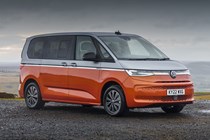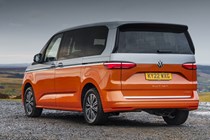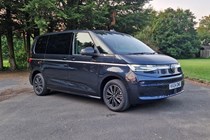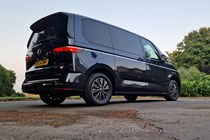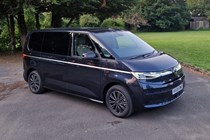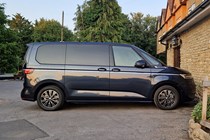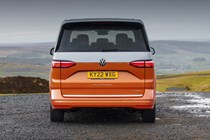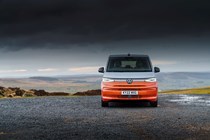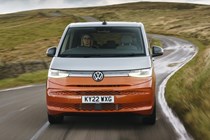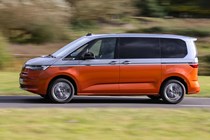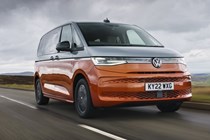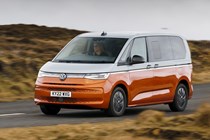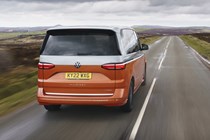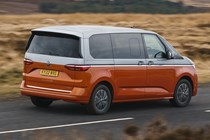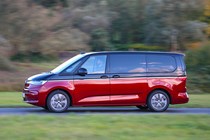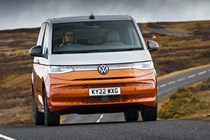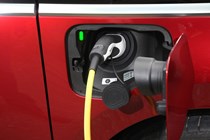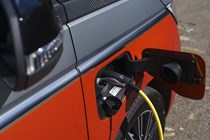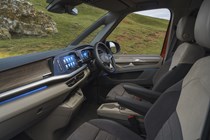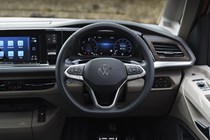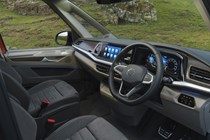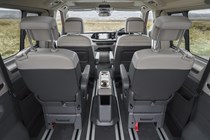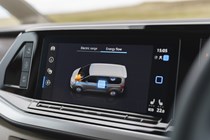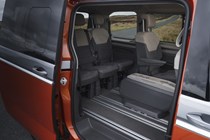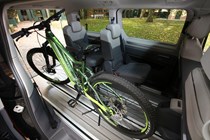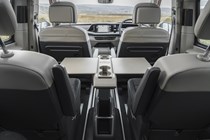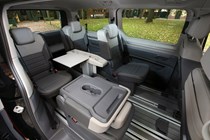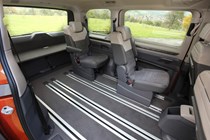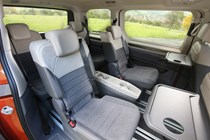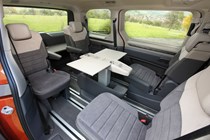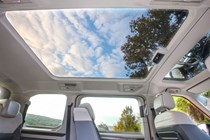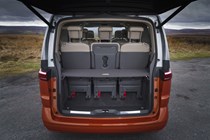
Volkswagen Multivan long-term test
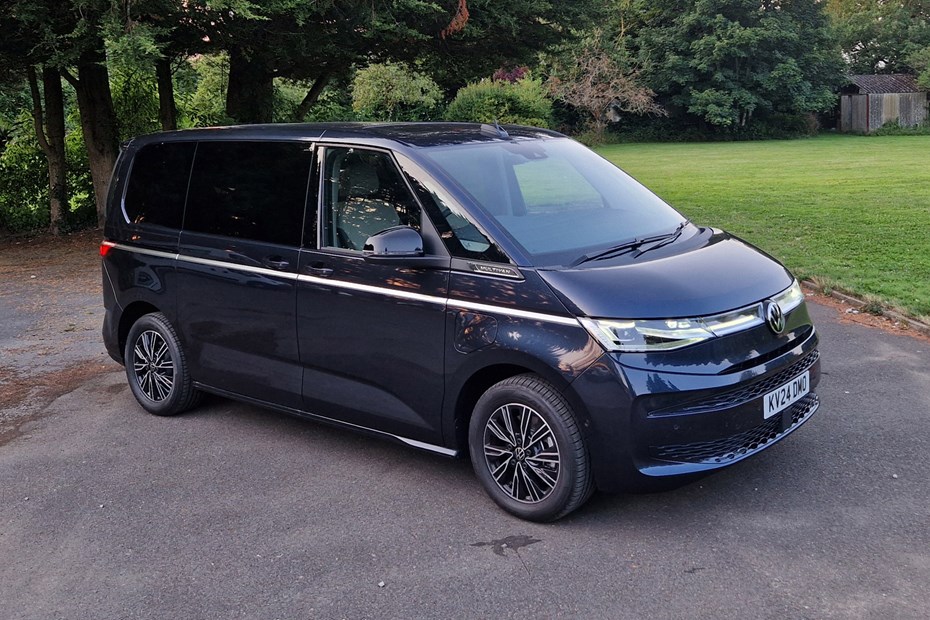
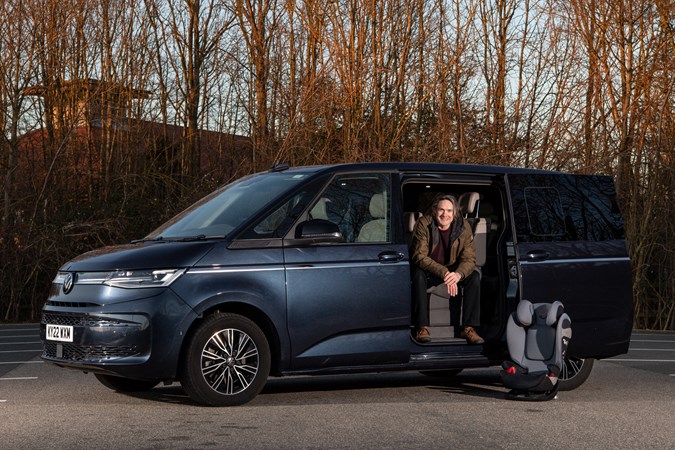
Welcome to the Parkers long-term test of the Volkswagen Multivan, in which we hope to prove or disprove that this is the best large people carrier on sale for growing families
Reports by CJ Hubbard
With a second child due within weeks and the need to regularly transport grandparents about, when our fleet finagler (hello Alan) asked if I would be interested in running a Volkswagen Multivan I nearly ripped his arm off with enthusiasm.
Built by Volkswagen Commercial Vehicles (and as the former Parkers Vans editor I’m very familiar with their work) but not actually a van in anything but vague proportion and stature, this is the most versatile people carrier VW currently sells in the UK. And my growing family felt like the ideal way to test it.
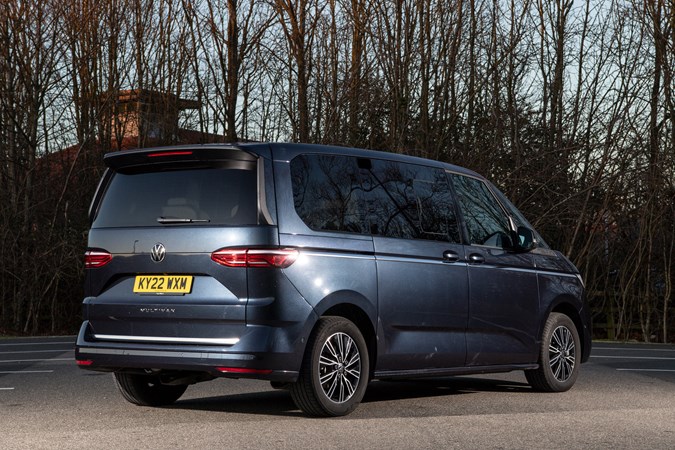
The example we’re running dodges the rather showy two-tone paint options in favour of the demur Starlight Blue Metallic all over, which contrasts nicely with the chrome beltline and diamond cut alloy wheels. These are 17 inches in diameter but appear much smaller thanks to the chunky sidewalls and the Multivan’s large body sides.
Finished in range-topping Style specification, our Multivan is also brimming with kit – personal favourites include the IQ.Light active matrix LED headlights, powered doors with keyless entry that works on the rear handles as well as the fronts (so handy when loading kids), and the heated steering wheel.
Optional extras include a vast panoramic roof, a wireless phone charger (which I’m very grateful for) and built-in sat-nav (which I’m less fussed about as it also has wireless Android Auto to take care of my navigational needs).
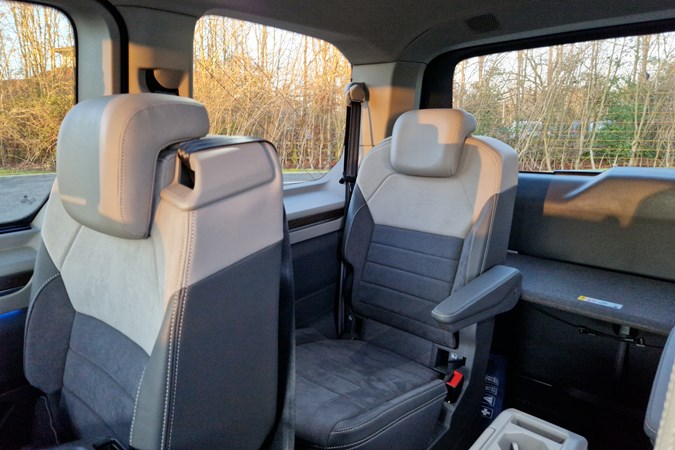
This is a standard-length model, which is good news for parking spaces but not so great if you need to carry a lot of luggage and a lot of passengers (if that’s consistently the case, go for the longer version). It’s also got a slightly curious six-seater layout.
The Multivan will easily accommodate seven full-size chairs, but not having the extra one means the adjustable table can slide right through from the front of the cabin to the very back (it uses the same rail system as the seats).
The one we’re driving is powered by a 2.0-litre turbo petrol engine producing a GTI-baiting 204hp and 320Nm of torque. This large van, powerful petrol combination is the kind of thing that would have been anathema a few years ago when diesel ruled the roost; these days its much more acceptable, and I’m already enjoying the keen 9.0-second 0-62mph performance.
First impressions are generally good…
I imagine they come across well in a showroom, these Multivans. The outside is smart, if perhaps a little too business-like for a family car in this colour – which could be perfect for a spacious executive shuttle. The Volkswagen identity is clear, and although it’s obviously a large vehicle, parked alongside a Transporter van or previous-generation VW Caravelle you’ll spot the lowered roofline, done not to make it appear squatter but to take the nerves out of entering a multistorey car park.
Open the doors (very smooth sliding action at the back), and you’re greeted by a functional but high-quality interior with nice surfaces where they’re most visible, tough ones in harder-worked locations. The door bins are big, the storage plentiful, and there are USB-C ports everywhere.
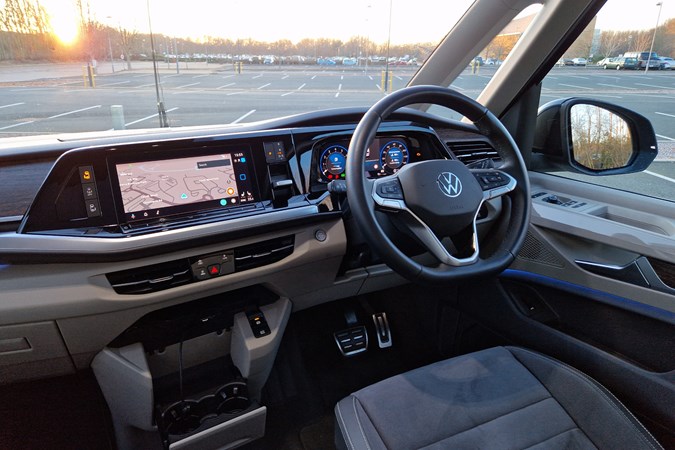
The limited boot space is a little jarring until you realise how easy it is to slide the seats around. Plus it’s relatively easy to remove individual chairs as required, although they are heavy and it might take two of you if you need to carry them any distance.
A sleek, customisable digital instrument cluster greets you on press of the start button. And while the Multivan is cursed with the same somewhat misguided touchscreen infotainment system and touch-sensitive secondary controls as other modern VWs, having spent several weeks running around in a Volkswagen ID.4, I am quite acclimatised to this now.
Seems like there might be a But…
Forward visibility is largely good, though you can’t see the nose of the van, which sticks out further than in many equivalents – including the Transporter / Caravelle. More irksome is the a-pillar arrangement. So large VW put a window in it, but still awkward when trying to place the Multivan accurately in corners.
I was more surprised by the ride quality and the refinement. On my first few journeys, the Multivan felt leaden-footed and noisy inside – jittery and harsh over bumps, with lots of road roar at motorway speeds (a common VWCV trait I’d expected the carpeted interior of the Multivan to pretty much eliminate). With so much tyre, I was expecting a much more pliant ride.
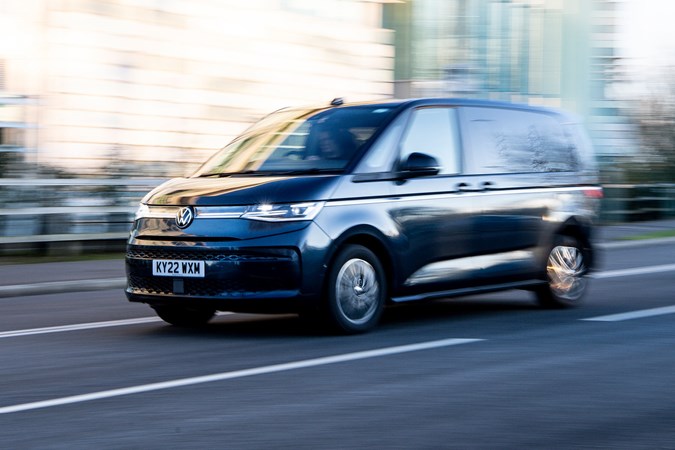
I was also taken aback by the drivetrain. Not the engine itself so much as the way the vehicle reacted to initial accelerator inputs – the van jerking forward away from standstill in an almost uncontrolled-feeling manner. In the past, the Volkswagen DSG automatic has been accused of lethargy but this seemed an overblown counter-reaction.
Frankly, weird.
Is there also a However?
There is. I have very quickly settled into the Multivan’s driving experience – noticing the ride and the refinement issues far less. As such, I’m wondering if I should just put them down to spending those previous weeks driving a modern VW electric car, which was virtually silent and surprisingly cossetting despite its significantly bigger wheels.
I’m still not clear what’s going on with the abrupt standing acceleration. A friend reckons there’s a way to reset a DSG’s learning parameters, and I might end up giving that a try; our Multivan came to us from the press fleet with plenty of miles on the clock and probably a sequence of less than sympathetic previous drivers, so I have high hopes.
I am dialled into the rest of its performance, though, and thoroughly enjoying how quickly it can overtake when required, which helps make short-work of my occasional post-pandemic commute.
Better yet, kiddo number one really likes the Multivan. Used to sitting up high in vans and pickups, she’s pleased to be back in a similarly commanding position. She’s also really taken with the powered sliding doors, and often saying ‘thank you van!’ whenever I open them for her remotely.
More soon.
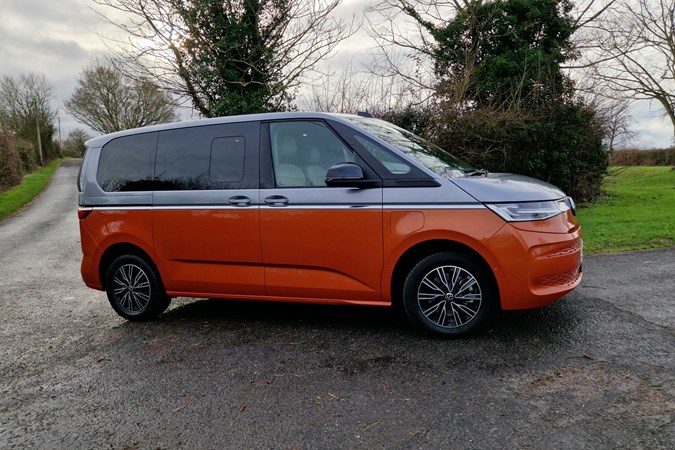
Update 2: Enter the super-sub – we put the Multivan eHybrid to the family test
Comparing the 2.0-litre TSI to the 1.4-litre eHybrid
The eagle-eyed among you will note that the Multivan pictured in this report is not the one at the stop of the page. Not sure what gives it away? Maybe the extra refuelling flap…
Yes, that’s right. In addition to being silver over bright orange, this is a Multivan eHybrid model – so instead of a 2.0-litre TSI turbo petrol engine under the bonnet it’s got a 1.4-litre TSI turbo petrol combined with an electric motor and a battery pack that’s theoretically good for around 30 miles of emissions-free motoring.
And emissions are the reason I’ve been driving it.
What’s happened to the other Multivan?
You remember that cold snap – I mean, the really cold one? Well, that kicked in the week my second child was due, which made it bad timing that suddenly whenever I started the blue Multivan I was greeted by a miasma of reeking fuel, as if it was running super-rich, or even burning oil.
The temperature surely couldn’t be a coincidence. And usually, when presented with this kind of a problem, I’d just take it to the local dealer. But with the incoming chaos of child number two, the press office agreed the smell didn’t seem right, and – once the kiddo had made her appearance, transported home from hospital in my wife’s Fiat 500 just to be on the safe side – the blue Multivan was whisked away and replaced by this much louder-looking number while they investigated.
I’ve ended up doing nearly 1,000 miles in it, so here are a few observations about family life with the Multivan eHybrid.
What’s it like to live with the Multivan eHybrid?
Aside from the paint and the powertrain, Multivan 2 arrived with seven individual seats (the blue one has the optional six-seater layout) – two of which I immediately removed to make room for all the stuff we needed to pack for a week away in Dorset. This left a vast boot space, but with no bulkhead or any other kind of divider I was conscious of the need to pack safely. Heavy stuff at the bottom, and so forth.
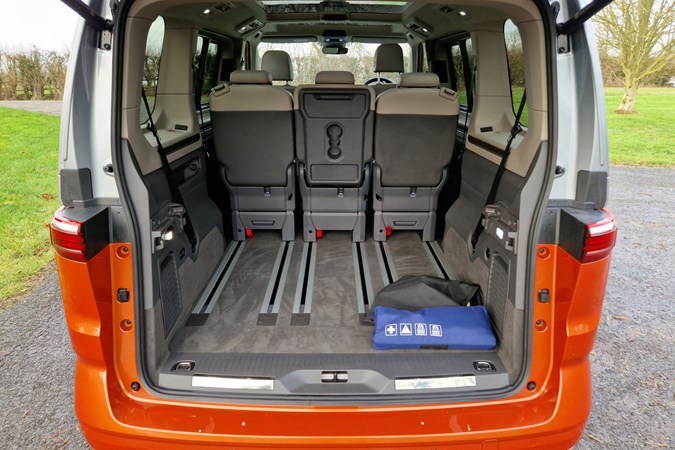
There’s a lot to like about the plug-in hybrid arrangement. The electric-only capability means you can glide silently about urban spaces, safe in the knowledge that you’re doing your bit to maximise air quality.
The Multivan has more than adequate performance in this mode, to the extent that on longer trips I found myself needing to actively manage when the car switched over to petrol power – otherwise it would simply use up all the e-juice straightaway and leave none for said silent gliding at the destination.
VW doesn’t make this especially easy. Controlling the powertrain is done via the central touchscreen, when I’d much rather have it as a button. At first it’s not immediately obvious you can also charge the batteries while driving along, either, as you need to access sub-menus to explain it. Then there’s the touchscreen slider for controlling the desired battery level, which can be a little tricky manage when moving. Once understood, it all makes sense – but you do have to take the time to figure it out.
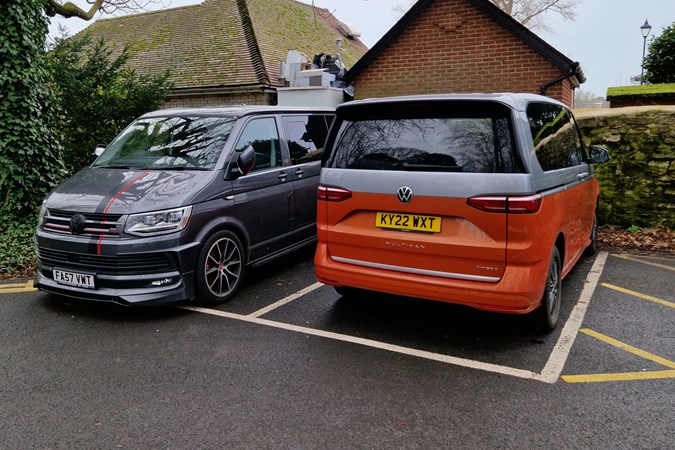
With the petrol engine and the electric motor combined the eHybrid produces 218hp, which is more than the 2.0-litre petrol. This makes those longer distances pass with ease, and even when the engine was being asked to cope with charging the batteries and travelling at motorway speeds, the Multivan never felt like it was shortchanging the driver. With four people onboard (two of them admittedly rather small) and a lot of luggage, I found this rather impressive.
Any other quirks?
One thing that kept tripping me up is that the eHybrid has a petrol flap release among the switches on the driver’s door. With the regular Multivan you simply press the flap and it pops open; I lost count of the number of times I forgot to use the switch in the eHybrid as a result.
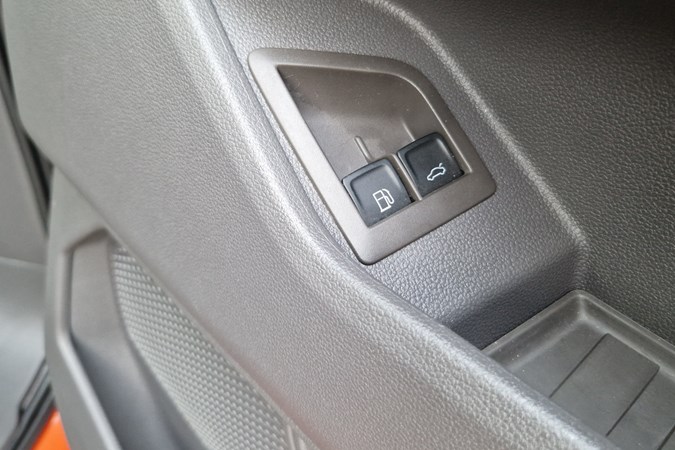
VW employs a similar arrangement on its other eHybrids, so it must be something to do with making sure people don’t plug the fuel tank into the mains. Or something. A minor quibble.
Slightly more annoying is that the eHybrid doesn’t have paddleshifters. Not a deal breaker, but another difference to consider.
How fuel efficient is the eHybrid?
Relying solely on charging the battery while driving – which is absolutely not the most efficient way to run a plug-in hybrid, it just made sense at the time – my bright orange and often fully loaded Multivan returned an average of 30.9mpg over 842 miles of hard motorway and urban crawling.
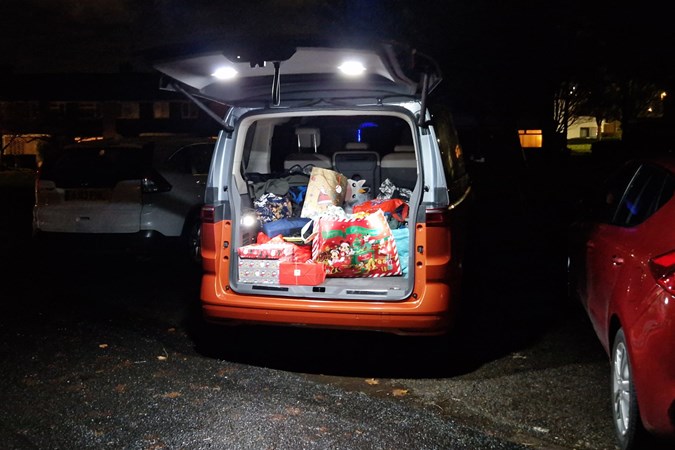
Honestly, I don’t think that’s too bad at all, considering the way it was driven and that my reference point in the 2.0-litre TSI is just over 23mpg. But if you took the official 156.9mpg WLTP figure at face value, that would probably give you a hell of a shock. So what gives?
Those test results take massive advantage of the electric-only running period; if you actually intend to purchase this version of the Multivan, you really need to be able to charge the battery on an electric-car friendly electricity tariff and do as much of your motoring as possible on electric power alone. With a short commute, this process could see to going weeks between visits to a fuel station.
So which version of the Multivan do you prefer?
Given the choice, I’d probably opt for the eHybrid. It’s not a huge amount more expensive – £59,035 versus £58,253, before options – and even driven without trying, the improvement in fuel economy was over a third. Plus I really like just wafting around on electric power alone, when given the opportunity.
I don’t get to keep the orange Multivan, though, as the blue one is due back any moment now…
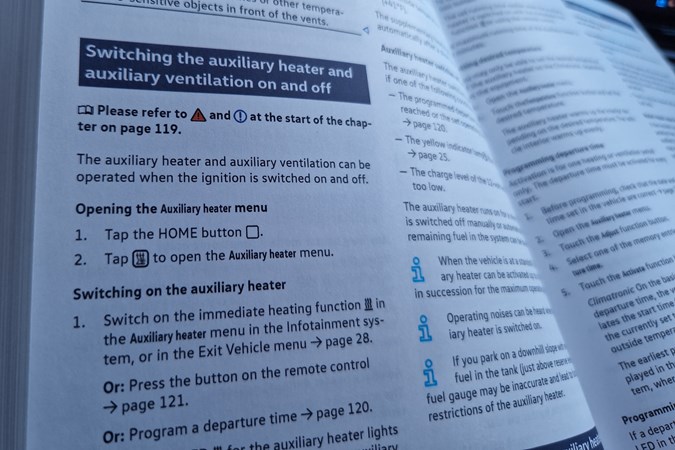
Update 3: Read the manual
In which CJ is an idiot
So, the blue Multivan is back. And what, you might ask, was wrong with it?
Absolutely nothing.
Wait a minute…
No, I wasn’t imagining the very strong fuely smell. But if I’d taken the trouble to read the manual I’d have discovered that the 2.0-litre petrol Multivan has a built-in auxiliary heater fitted as standard, and this kicks in automatically once the temperature drops below 4 degrees C in an effort to warm the cabin more quickly.
Thank goodness the Volkswagen press office has a sense of humour about these things – suffice to say I was slightly embarrassed.
But what about the smell?
This is a good point. Because intentional or not, the way it sends fumes through the cabin is not something I was particularly keen to put up with. As I was reminded when the temperatures plunged again shortly after the blue bus’s return.
Once you do read the manual, however, you’ll learn that the auxiliary heater can be switched off.
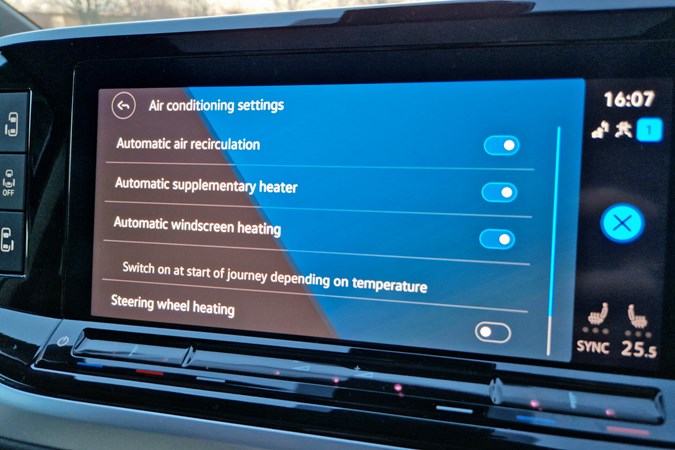
It probably won’t surprise anyone to learn that the control for this is buried in the touchscreen infotainment system (and I’ll admit I was confused somewhat by the other auxiliary-heater features mentioned in the same section of the manual that this particular Multivan most definitely doesn’t have). But once located, salvation is just a tap away.
It took a couple of days for the fumes to fade completely. Since then, though, we’ve been fume free on all occasions, no matter how cold the starting temperature. And frankly, I’m happy to put up with a few extra moments of cold in the cabin in order to breathe clearer air.
Is it good to have the 2.0-litre turbo back?
At the end of the previous report, I mentioned how much I’d appreciated driving the eHybrid – which suffers no performance loss and seemed to be enjoying unignorably better fuel economy for not much extra outlay.
But now I’m back in the blue Multivan, I also can’t ignore how much I enjoy the thuggish, no-nonsense nature of the bigger turbo’s power delivery and performance. It is a remarkably satisfying thing to knock-around in.
Plus I swear the DSG is behaving less abruptly than it did before it went away, though maybe that’s just because I’ve trained myself to manually release the electronic parking brake, rather than waiting for it happen automagically.
What’s more, the latest fuel calculations show it now basically matching the eHybrid’s 30mpg in the real world – amazing a difference the kind of driving you’re doing can make to efficiency.
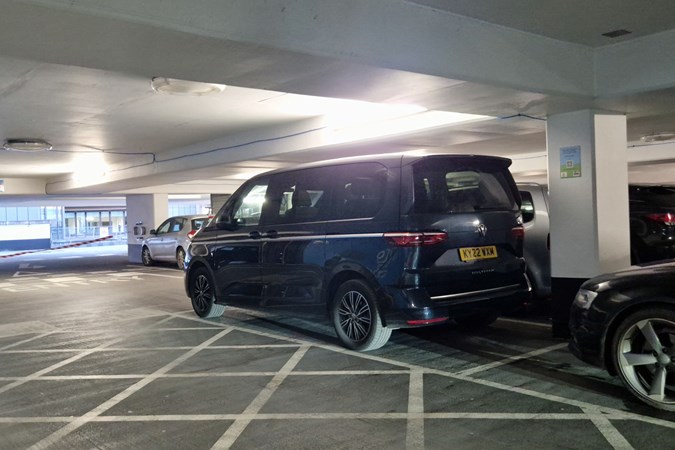
Update 4: Safety, critical?
Modern safety tech is a marvel. Or is it?
The Multivan is packed with modern safety equipment – which is as it should be, for who wants to drive around in a car that isn’t going to look after you as well as the alternatives?
But modern in this context inevitably means active intervention, which in turn means accepting that the Volkswagen is occasionally going to make some decisions for you…
Lane keeping: good
By this point in my motoring journalism career I’ve pretty much made peace with active lane keeping, to the extent that I rarely bother to turn it off. Yes, this does occasionally nibble at the steering wheel and sometimes gets quite seriously involved in putting you onto the line it thinks you should take into a corner, but in the Multivan I’m yet to experience it doing anything truly alarming (earlier VW systems could get hugely confused by road works) and I’m happy to have it keeping vigil in the background. Especially when I’ve got two potentially distracting children on board.
Blind spot monitoring is a no brainer as well.
AEB: acceptable
Similarly, it’s hard to argue against the forward autonomous emergency braking – even if it can be a little over-zealous. The cyclists around Cambridge are occasionally proving a bit of a challenge to its parameters, especially the ones who choose to merge from a side road without slowing.
In one vividly memorable instance, the VW mistakenly assumed said cyclist was going to ride right out in front of us, activating the crash alarm and throwing on the anchors. Hard to blame the car for this, but I’m not sure that would be much consolation if the vehicle behind hadn’t also been able to stop in time. The human eyeball / brain combo is still capable of making better decisions, but AEB again represents a welcome safety net.

Rear traffic alert: not so sure
The system I’m least certain about is the rear autonomous braking capability. But my relationship with this system is ambiguous, complicated by the undeniable fact that it absolutely prevented me from causing an accident while baby-brained shortly after the arrival of child two. I quite literally nearly reversed into a car I simply didn’t see at a set of traffic lights, but the technology successfully intervened to prevent an impact.
As with all such systems, however, it came in so hard that I thought I had crashed. That’s an acceptable consequence in that instance – I’ll gladly take the jolt and the confusion over the insurance claim – but it feels much less appropriate when you’re carefully reversing into a parking space and the full force of this emergency braking power is activated for no real cause.
As far as the computer logic is concerned, there is a cause, of course – usually it seems to have detected the movement of an approaching vehicle. But if I weren’t on paternity leave I’d be really interested in pursuing further conversation with the people responsible for the parameters of this, as in every instance aside from the baby brain / traffic light absurdity on my part, the perceived danger has been of no account whatsoever.
Once more, it’s hard to argue against the default to caution. But lord knows what passers-by think when your Multivan slams to a halt mid parking-manoeuvre for no apparent reason. Probably they think there’s an idiot behind the wheel. Which in my case might be correct. Ahem.
Euro NCAP: five stars
Never mind what I think: the Multivan has a full five-star Euro NCAP crash safety rating. Not least of which is an 89% score for child safety (just 1% shy of its rating for adults) – ideal for a family MPV.
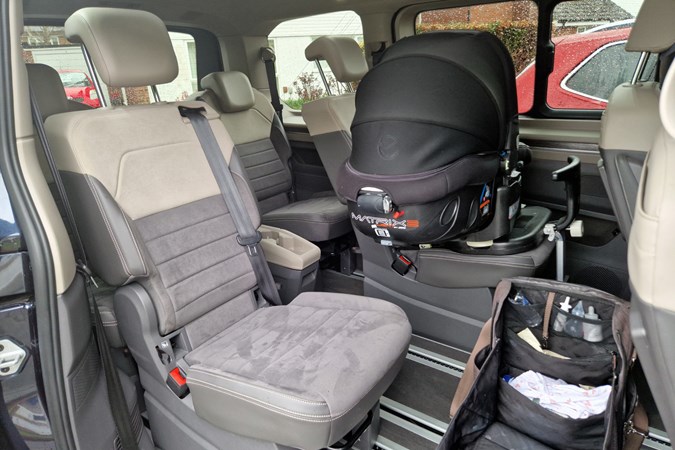
Update 5: Van and baby
So, I’ve spent a lot of time carting around a very small child in this very large van, which probably seems rather unnecessary if you haven’t experienced the convenience of it. So here are a few quick thoughts on why a vehicle such as the Multivan makes for an excellent mobile creche.
Size doesn’t always equal safety, but the tiny kiddo always feels consistently well cocooned in this thing. The way the seats work means I can easily Isofix her right in the centre of the Multivan, putting her as far as possible from any point of impact.
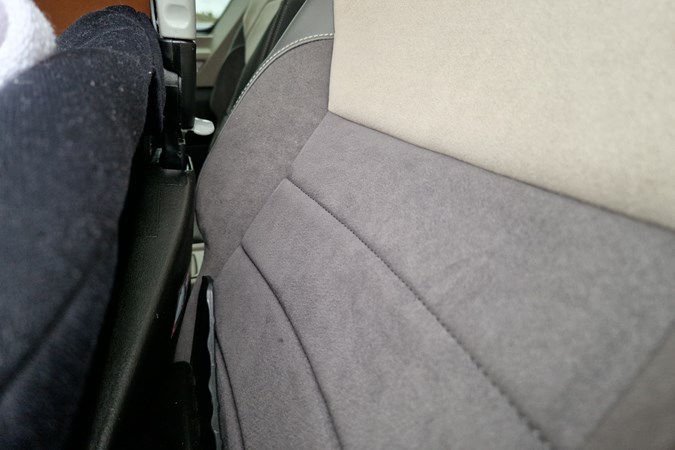
As it happens, we have a slightly unusually lay-flat car seat, so usually she’s at one of the edges. Initially, I was rather concerned the arrangement of this and its chunky Isofix base would end up doing permanent damage to the surprisingly sculpted seat bolsters – both base and carry unit were making contact there – but then I remembered the Multivan’s seats also recline, making it easy to adjust the point of contact out of existence.
The boot of the short-wheelbase Multivan isn’t quite as generous as you might expect, but even with all six seats available in place, I can still get the buggy wheels in the back if required. With two of the seats chucked (sorry, huffed and puffed – as previously remarked, they are heavy) in the garage, you can just throw the travel system into the back without even collapsing it. Just make sure you put the brake on…

Sticking with the obvious, the sliding side doors making getting the kiddo in and out a dream. And while the massive tailgate is often problematic in carparks, being able to walk through the cabin to the back of the vehicle means it’s still easy to access stuff when you can’t open this.
Finally, three cheers for the flat floor. As this makes for a very convenient platform for our mobile changing station (a clever backpack).
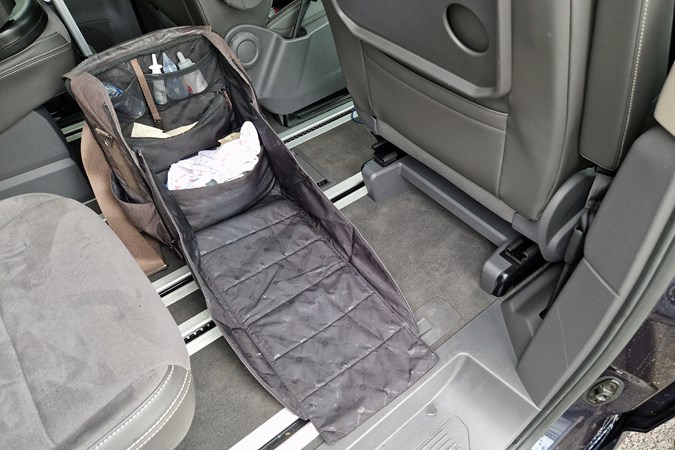
So while the Multivan’s size – and cost – surely are a luxury for a young family, the benefits to me are certainly clear.
Report 6: Our charitable act for the year
Report by Tom Wiltshire
Vans are useful, vans with seats even more so – so when Parkers was asked if we could support some of our colleagues from other departments in organising a charity bike ride, we jumped at the opportunity to prove our worth by offering up our long-term VWs.
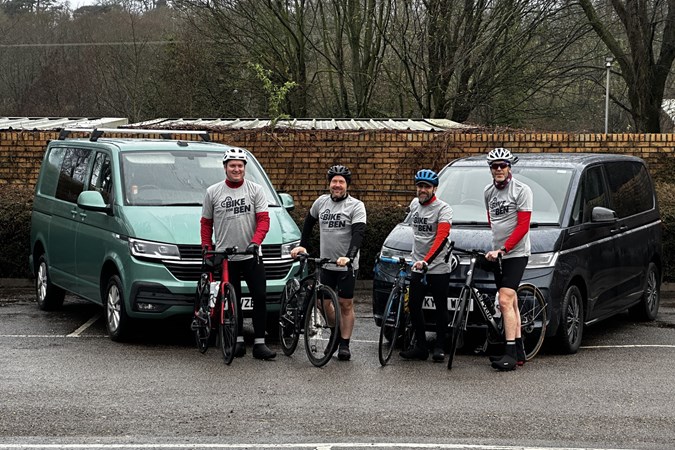
Both Adam Binnie’s VW Transporter Kombi and CJ’s VW Multivan would be pressed into the service over the course of the ride, which was to raise money to support the daughter of a late colleague. The plan was pretty simple – the ride was from Morecambe to Redcar, across the width of the fabled land I know as ‘The North’.
With us being based in Peterborough, the van’s first task would be to get our four riders along with all their luggage and equipment up there. Then, we’d follow them along their route, meeting up at coffee stops to make sure everyone was fed, watered and in fine mechanical fettle.
Aren’t the Transporter and the Multivan the same?
Not any more! As CJ’s mentioned, the Multivan replaces the old Transporter-based Caravelle, but is itself more closely related to VW’s passenger cars. Driving it back-to-back with the Transporter really highlights this.
The Transporter is a comfortable van – honestly – but next to the Multivan its origins as a working vehicle shine through. The Multivan’s refinement and comfort are on another level, down to things as simple as the driving position, which is low-set and comfortable with the wheel in front of you rather than underneath you.
Volume levels are the biggest upgrade, in my opinion – the Transporter is fairly noisy, especially with its large, open and echoey load area at the rear. And that volume is something the relatively puny stereo struggles to overcome, with quieter detail washed out of the music.
No such irritations in the Multivan, which has speakers in all three rows of seats and enough sound deadening that you can actually hear them.
The ride
After a painless trip from Peterborough to Morecambe – during which the Multivan sat happily at the national speed limit and returned an impressive 37mpg from its 2.0-litre petrol engine – we set off bright and early the next morning. Rather than following the riders all the way, we decided to go ahead to each stop and wait for them there.
The Multivan dealt beautifully with all the winding country roads, with a quicker steering rack than most vans meaning less arm-twiddling. It was navigating the small villages of the Yorkshire Dales where the Multivan’s seven-speed automatic came into its own – one less thing to worry about when every drystone wall is capable of taking a mirror off.
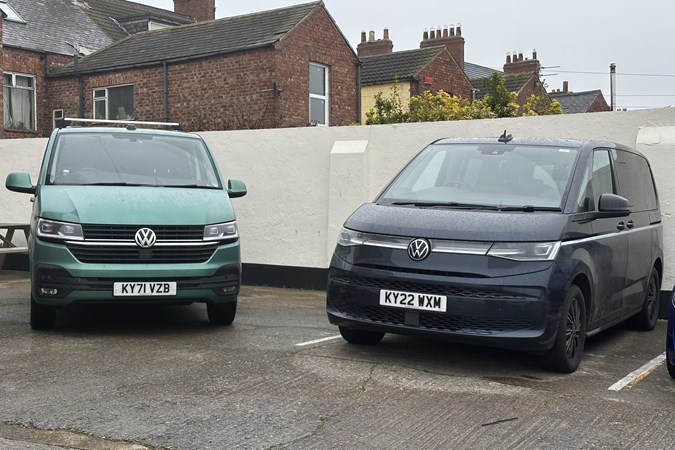
I also found myself really appreciating the comfortable (and very adjustable) driver’s seat, as a bout of illness the night before had kept me up – and meant I needed a nap at every stop. No problem, though our van’s black paint and blindless panoramic glass roof did heat up the interior quite quickly.
Happily, apart from my own illness, the ride proved totally uneventful. All four of our riders finished in good time and over £4,000 was raised for Ben’s daughter – a resounding success.
Final thoughts
There really aren’t many big MPVs left. The Ford S-Max and Galaxy aren’t long for this world, van-based alternatives from the Citroen Berlingo to the Renault Trafic have commercial origins and feel like it and a seven-seat SUV just doesn’t cut it in terms of practicality.
That puts the Multivan in a class of pretty much one – it’s this, or a V-Class. Personally, I know where my money’s going – I’ll take my Multivan in two-tone orange, though.
Update 7: Goodbye to the Multivan
Family motoring doesn’t come any more practical than this
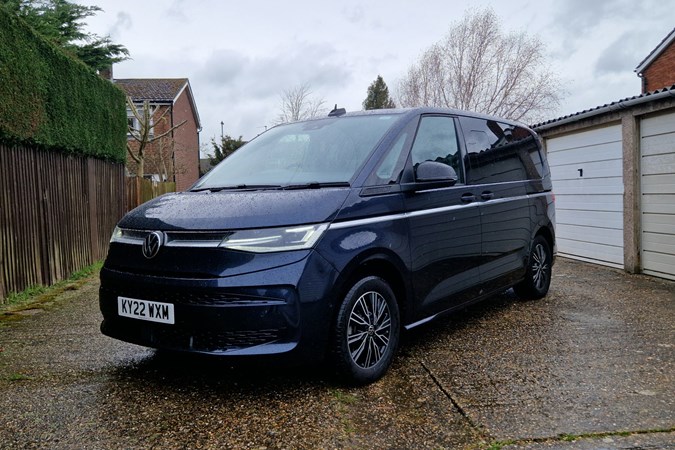
It was a dark day when the man came to take the Multivan away. As family transport goes, there’s still nothing to really beat a dedicated MPV, and this VW successfully straddles the line between those based on cars and those with the interior capacity of a van. Add the flexible nature of the seating layout, and my experience has been one of generally blissful family practicality.
Space aside, what did the Multivan do well?
Unlike some other people carriers, it has enough style to make you proud to be piloting it – carrying on a long Volkswagen tradition of making pragmatic vehicles alluring, too – and enough presence to attract the attention of other road users in a very positive way. Slower traffic noticeably and consistently moved out of the way on motorways, and I never found myself stuck waiting to get out at busy junctions.
And although we had a bit of fun and games with the auxiliary heater, nothing went wrong with it either. Things haven’t always been smooth sailing with modern VWs in this regard, but the Multivan is shaping up to be exactly as dependable as you’d hope. At least in our experience.
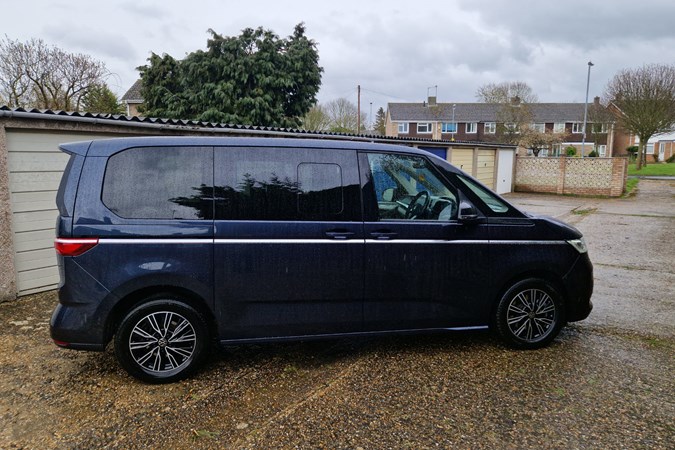
With electrically operated doors and plenty of other electronics on a still relatively new product, this wasn’t necessarily a given. So, it was also pleasing to be able put it to the test for an extended period of time.
No matter how loaded, performance from the 2.0-litre turbo was never less than thoroughly adequate, and often much more so. This is a big bus that can really shake a leg if it needs to.
Is there anything you’d like to improve?
I always found the ride comfort a little stiff and unwieldy – I’ve since switched into a Tiguan Allspace, and that’s notably more compliant, especially over broken urban surfaces. However, passengers never felt the need to complain, and the rigid structure is still preferable to a floppy frame in this kind of machine.
Similarly, the current generation of Volkswagen infotainment has faced plenty of criticism on the pages of this website and other places. It features fiddly touch-sensitive controls and puts too many vehicle functions under the cosh of the central screen. But the frank reality is that you do get used to this in a relatively short space of time – and I suspect that most buyers will shortcut some of the issues by plugging into Apple CarPlay or Android Auto.
Was it expensive to run?
A powerful petrol engine in a large vehicle shaped basically like a chiselled brick was never going to be a recipe for maximum mpg, but you are going to have to be prepared to put your hand in your pocket here. Probably a lot.
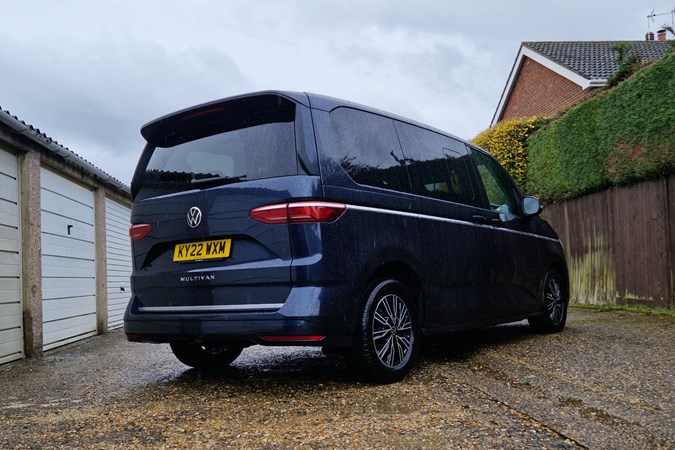
During the few thousand miles we covered during our custodianship, the Multivan averaged just over 28mpg. At today’s fuel prices that’s going to be costly, no two ways about it.
Would you want to own one?
Assuming I could afford to keep putting fuel in it at that rate, yes I really would. A car of this size may seem indulgent with just two small children to carry about most of the time, the ability to configure the interior to suit the needs of the particular adventure really appeals.
Sliding doors are brilliant in car parks, the tailgate is a great makeshift shelter from the rain, and the flat floor combined with the walkthrough cabin is the sort of feature you don’t realise the usefulness of until you’ve experienced it.
But the real strength of the Multivan is that it’s just so holistically put together. This is a purpose-built people carrier that benefits from van-like dimensions while offering a more familiar driving experience and all the associated creature comforts. Nobody else builds anything quite like it, and for those looking for maximum practicality but minimal culture shock, it’s even better than it really needs to be.
| VW Multivan Style 2.0-litre TSI | |
|---|---|
| Total mileage | 10,468 |
| Real-world average fuel economy | 28.09mpg (overall) |
| Official combined fuel economy (WLTP) | 31.0-31.4mpg |
| Parkers mpp (Miles per Pound) calculation | 4.5-5.2mpp |
| Time on Parkers’ fleet | December 2022 – March 2023 |



